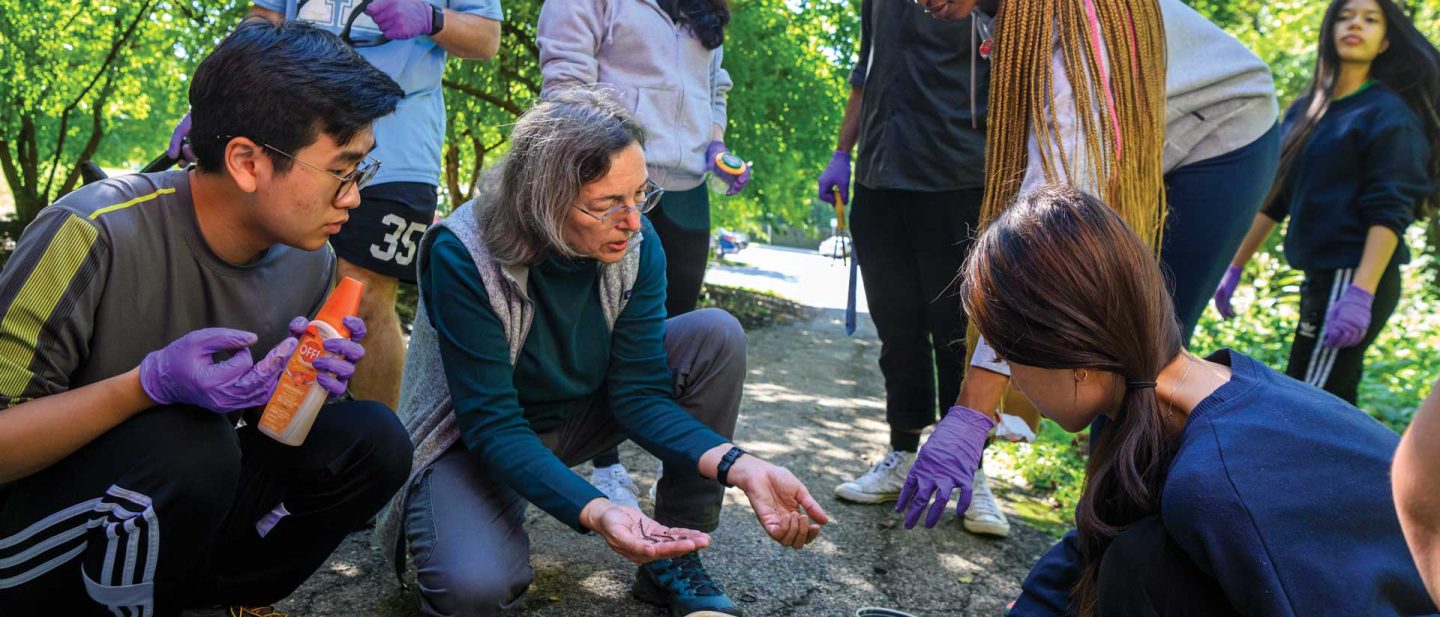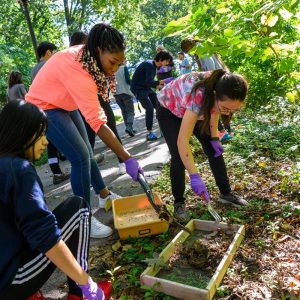
In Dr. Katalin Szlavecz’s Soil Ecology (AS.270.332) course, students are introduced to soil ecosystems and data collection methods both in the laboratory and the field. The ten-student class is an upper-level undergraduate course within the AS Department of Earth and Planetary Sciences.
Ursula Humayun, a senior from Florida studying Molecular and Cellular Biology, is currently enrolled in the course.
We sat down with Ursula and Dr. Szlavecz to learn more about Soil Ecology.
What can students expect to learn from this class?
“I am a great believer in experiential education and hands-on learning,” says Dr. Szlavecz. “Learning about soil cannot be done in the classroom.”
Throughout the course, students learn about soil properties (physical, chemical, and biological) and how to sample and measure them. The course provides an introduction to soil development, including how soil evolves, what the major drivers of soil development are, soil color, soil organic matter, and soil compaction. Functional aspects of soil, such as decomposition and infiltration, are studied as well.
I am a great believer in experiential education and hands-on learning.”
A large focus of the class is on soil invertebrate sampling and extraction. Students learn the major invertebrate taxa, including their functions in the soil and their natural history. In doing so, students learn about soil biodiversity.
Such lessons are conveyed primarily through soil sampling, data collection, and processing — a “hands-on” learning approach that Dr. Szlavecz values.
How would you describe the class to students interested in taking it?
“This is a great class for someone that wants to learn more about things they interact with all the time, and to open their eyes to things that we take for granted,” says Ursula.
“Everyone has touched soil and not known what’s going on inside. There is always more about soil that you can learn. With the urban soil focus of the class, we are talking about what’s here with us in Baltimore, what’s in the built environments that we live in, and what sort of impacts human actions have had.”
“It definitely feels like a class that is present and grounded.”
How does this class intersect with environmentalism?
“We devote time to environmental issues related to soil,” says Dr. Szlavecz. “Especially soil erosion and different forms of degradation, including: salinization, contamination, effects of climate change on soil properties, and effects of different disturbances, such as fires or grazing.”
Students often read papers and hold discussions to study such issues of environmental impacts.
To conduct sampling, however, the class visits sites both on and off the Homewood campus. Historically, the class has conducted soil sampling around Homewood and compared different land uses by sampling in a variety of sites (grassy areas, forest patches, open areas). This on-campus work captures the intentions of the campus as living lab effort, utilizing JHU’s campuses as test beds for research.

This fall, sampling has taken place on an improved vacant lot in Baltimore City that was converted into a community farm. Oliver Community Farm is maintained by a nonprofit, The 6th Branch (T6B), which is a veteran-led organization dedicated to “transforming vacant land into neighborhood green space,” according to the T6B website.
The class is collecting data for study, but also provides data to T6B. The partnership with T6B began this year, growing out of the Baltimore Social-Environmental Collaborative.
Depending on the year and the class size, the class may also visit the USDA Agricultural Research Center in Beltsville, Maryland or the Smithsonian Environmental Research Center in Edgewater, Maryland.
What motivated you to teach this class?
“My background is in soil ecology. This is my research interest,” says Dr. Szlavecz. “When I started to teach this course, the environmental science and environmental studies majors that are successful today did not exist.”
What motivated me was to fill this niche of having a course which specifically focused on the soil ecosystem.”
“I always thought that the course offerings were missing a field component. What motivated me was to fill this niche of having a course which specifically focused on the soil ecosystem.”
Dr. Szlavecz also co-teaches Field Methods in Ecology (AS.270.338), another field-based course, every other year.
What motivated you to take this class?
“My dad does geochemistry, and I am mostly biology, but I find his work very interesting,” says Ursula. “As a kid, I would go into the lab with him. Earth sciences buildings all have a certain vibe to them that is very nostalgic, so having a class in Olin Hall for the first time is really fun because I walk in and think: there are geologists here.”
For Ursula, the Soil Ecology course does not contribute to her major, credit-wise. She thought, however, that it sounded interesting and that it was adjacent to the biological research that she conducts.
“Through my research and studying the bacteria that I work with, I’ve learned about the complex nature of soil relationships,” says Ursula.
What broader themes do you hope that students take away from this class?
“We live in the city, and one of my research areas is urban soils, so we talk quite a bit about how urbanization affects soil conditions,” says Dr. Szlavecz. “Even though we have this green space on campus, it is very highly altered because people are physically or chemically modifying conditions. The soils that we are looking at are not naturally developing soils.”
The course covers heavy metal contamination, acid precipitation, salinization, and their effects on soil conditions, as well.
 Dr. Szlavecz also values teamwork, and facilitates this through the structure of the course.
Dr. Szlavecz also values teamwork, and facilitates this through the structure of the course.
“When we go out in the field, we work in teams,” says Dr. Szlavecz. “It’s important, especially in this competitive world, that students collect data together. It’s fun, because we can learn from each other.”
It’s important, especially in this competitive world, that students collect data together.”
The whole class shares a collective data set. Reports and discussions, then, are based on what the class collects as a whole. There is an individual project and presentation component, but most of the class is collaborative in nature.
What has surprised you most about taking this course?
Ursula was surprised by the hands-on field work aspect of the course, along with some of the content she has learned. “I assumed that you would see the highest soil diversity in places where you hear about megafauna biodiversity, like the Amazon Rainforest or the Tropics,” says Ursula. “When I did my presentation on nematodes, I learned that they really like a lot of organics in the soil. Tropical soils tend to be pretty poor, actually. Instead, nematodes love the boreal forest and the tundra.”
What has surprised you most about teaching this course?
“There are students coming from different backgrounds,” says Dr. Szlavecz. “I teach students majoring in Environmental Science, but I teach some students from the engineering school, or even students with backgrounds in art. These students bring in different views of the same thing. Everybody knows what soil is, relates or doesn’t relate to it, and I think our discussions are generally more interesting because of that.”
“Almost everyone is surprised to learn how rich soil life is. We rarely discuss soil biodiversity despite the fact that about half the species on earth inhabit the soil at some point in their life cycle.”